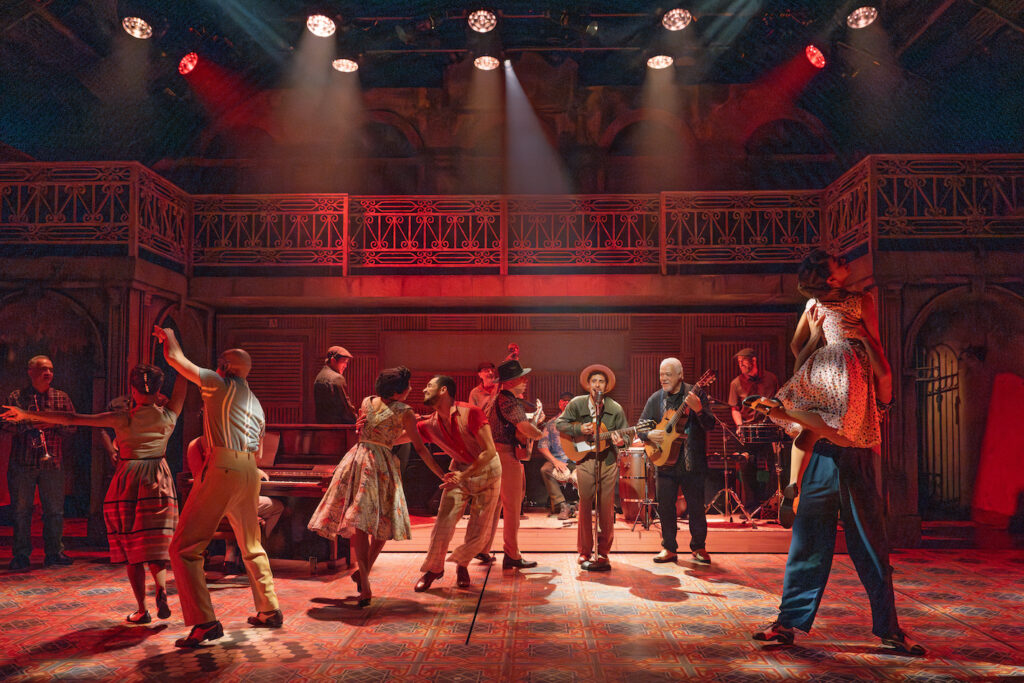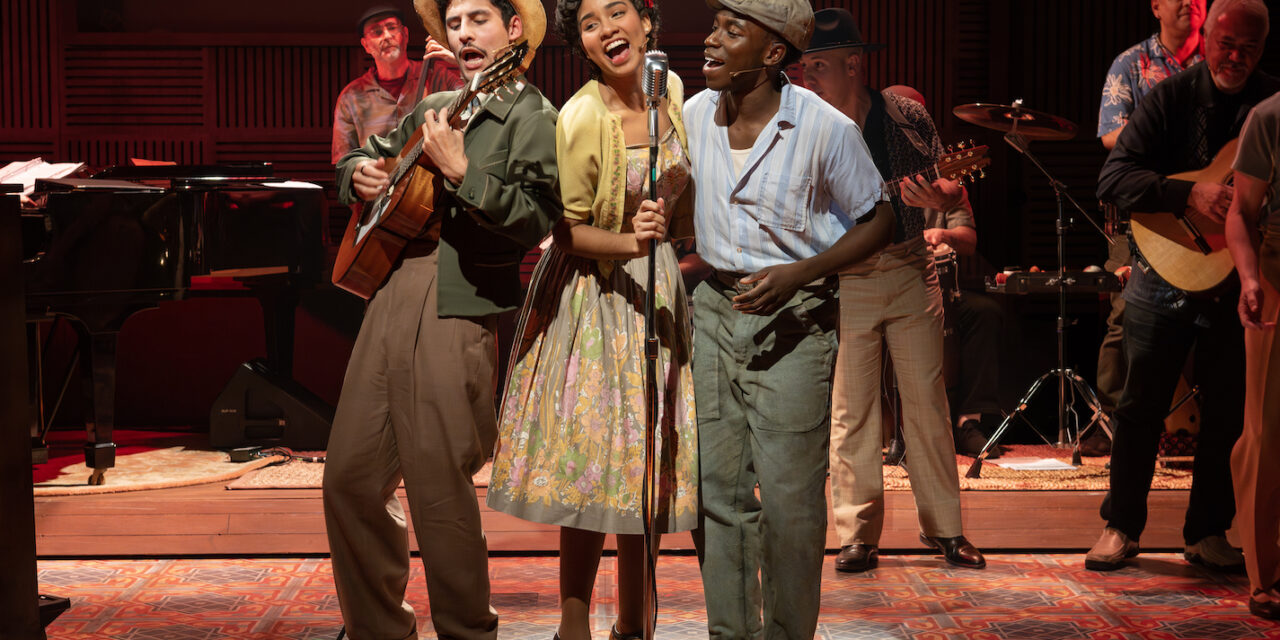Theater Review by Carol Rocamora . . . .
Final Extension thru January 28 . . .
There are musicals that entertain, and then there are musicals that transport us, elevating us to a higher ground. Buena Vista Social Club, the unique and inspiring new musical now playing at the Atlantic Theater Company, is a story of how music transcends time and politics to become the lasting expression of a nation’s cultural and spiritual identity.
The idea for the musical was born a few years ago when Cuban-American playwright Marco Ramirez was approached to consider writing a musical about a group of veteran Cuban musicians who, in 1996, made an album of original Cuban music. They had played together forty years earlier in a club near Havana, during the hopeful pre-revolutionary 1950s before Castro came to power. “We know there’s a great big storm outside,” says one of the group’s founders of the early years, “but here we don’t hear any of that . . . All we hear is music.”

The story that Ramirez decided to tell is inspired by real people and events—but takes some liberties to express “the emotional truth behind the factual truth,” as he told the New York Times in a recent interview. Set in 1996, it features a young record producer named Juan who seeks to gather the musicians from forty years ago to make an album of the songs they sang and played together, in the 1950s, at a community center called the Buena Vista Social Club. There follows a series of flashbacks—back and forth from 1996 to 1956—as Juan gathers the musicians together, reuniting them one by one. They feature Omara, the charismatic female singer; the extraordinary lead guitarist Eliades Ochoa; and a charming young Black Cuban singer named Ibrahim.
Ramirez’s flashback scenes provide for double casting of the lead roles—hence there is an Omara in the 1996 scenes (a commanding Natalie Venetia Belcon) and a younger Omara in the 1956 scenes (Kenya Browne); an older Ibrahim (Mel Seme) and a Young Ibrahim (Olly Sholotan); an older Compay (Julio Monge) and Young Compay (Jared Machado), and so on. Their passionate performances are memorable.


Ramirez intensifies the story with its historical context. For example, Ibrahim, who spent a week’s savings on a new pair of shoes to audition for the ensemble in 1956, was forced to play under the stage because of his color—as was required in that era. (When they sing together again, in 1996, Omara insists that Ibrahim’s face be on the new album cover.) Then there was the larger issue of politics (Castro was on the rise) that divides Omara and her sister Haydee, singers who perform together. “You don’t belong here,” cries Haydee (Danaya Esperanza), as she and her parents plan to flee Cuba in 1956. She implores Omara to leave with them, saying: “The world is on fire, and you’re singing pretty songs!” But Omara insists on staying. “I want to sing for our people,” she declares, as her family leaves the country on an airplane, never to be reunited again. As Compay describes it, “I remember a time when there were all kinds of people on this island, but now there were only two types of Cubans: those who stayed and those who left.”


The spirited story of how they gather in 1996 to make the nostalgic retrospective recording is fueled by the fabulous original Cuban music of the 1950s. The score consists of fifteen numbers played by a sensational band of ten musicians, all of whom were recruited based on familiarity with Cuban music. (For example, Renesito Avich, the dazzling lead guitarist, knew Eliades, the role he played, and admired him as a mentor.) Together these talented musicians form an ensemble so harmonious that it’s hard to believe they hadn’t been playing together their entire careers! Numbers like “Candela!” which featured two guitarists (Avich and David Oquendo) and solos on flute (Hery Paz), trumpet (Guido Gonzales), and trombone (Edward Venegas), inspired cheers from the audience on the evening I attended. There were romantic numbers, too, like “Dos Gardenias” (featuring a honey-voiced Belcon) that were sensuous and nostalgic.
To add to this powerful score, Patricia Delgado and Justin Peck’s choreography sets the stage on fire. An ensemble of six dancers performed in all the musical numbers, dancing in a variety of balletic, Afro-Cuban, modern, and social styles. There is the bonus of two young dancers performing moving duets, representing these tragically divided sisters. At one moment early in Act I, the band joins in the choreography as well! Directed by Saheem Ali, the cumulative energy of all these elements is electrifying.


1996 was a period in Cuban history called the “Special Period,” when the harsh Castro regime and the US blockade made life hard for residents of the country. Juan’s goal was to rekindle national pride in Cuban culture and showcase the power of music. As Juan says, he fervently believes that “one little record might be enough to remind the world . . . that Mozart’s got nothing on us!” Wim Wenders’s 1999 documentary, Buena Vista Social Club, also reminded the world that although the Cuban culture is thousands of miles away, “a sound like this tends to travel” (Juan’s words, again).
Judging by the ecstatic audience response at the preview I attended, Buena Vista Social Club is for everyone in these divided times who seeks spiritual unity and can find it in music—and in the theater.
Buena Vista Social Club. Extended Through January 28, 2024, at the Atlantic Theater Company’s Linda Gross Theater (336 West 20th Street, between Eighth and Ninth Avenues). www.atlantictheater.org
Photos: Ahron R. Foster
Cover photo: Jared Machado, Kenya Browne and Olly Sholotan


















